Is it a poor man’s V-Max or simply Honda hubris? Scoop hurtles towards the horizon on his mate’s Honda V65 Magna – known affectionately as ‘Red Molly’!

Words: Steve Cooper Pics: Gary Chapman
I’ve known this bike for almost as long as I’ve known its owner Andy Jones. For longer than either of us care to remember the Honda V65, known by close associates as Red Molly, was variously a pile of parts, a semi-completed build and perennially work-in-progress.
When he wasn’t spannering on customers’ bikes, Molly would receive some TLC and the pair of us often pondered just what 1098ccs of cruiser-style Honda V4 might be like to actually ride. We concluded that ‘bloody dangerous’ might be just one of the phrases called into play and ‘downright scary’ could very well go on to cover most, if not every base; it is something of ‘a unit’ after all.
When Andy and Molly decamped to rural Lincolnshire the bike finally had been sorted and after years of enforced stasis the beast was carefully goaded with a long, pointed, stick before finally awoken with a cautious press of the ‘go button’. Subsequently, Andy’s summation as to the bike’s attitude was (to be read in a broad Norfolk accent): “That goo-like stink booy! But yer don’t wanna be taking liberties with ’er cos I think she might turn round and bite yer!” One evening after his first full ride, he dropped the following into the conversation: “Do yer wanna ride her for CMM?” Hell, why not? In for a penny in for a pound as they say.
Fast-forward to some decent weather simply because you really don’t want to be hustling an American-orientated power cruiser around wet, narrow Lincolnshire lanes and I’m face-to-face with the completed and road-proven leviathan. In the words of Minder’s Arthur Daley: “Oh my good God Terry!’ The thing is a brute. Pretty much everything about the bike is there to make an impression or a statement and subtle it ain’t. This is two-wheeled ostentation on a monumental scale.
By the time this bike was happily rippling the asphalt stateside the Japanese factory custom bike had been well underway for a fair while. Folk variously claim that it was either Yamaha’s XS650SE or Kawasaki’s Z650CSR that initiated the cult of the metric cruiser, but in comparison to the Honda here they were very much exploratory toes dangled in a luke-warm pool of water.
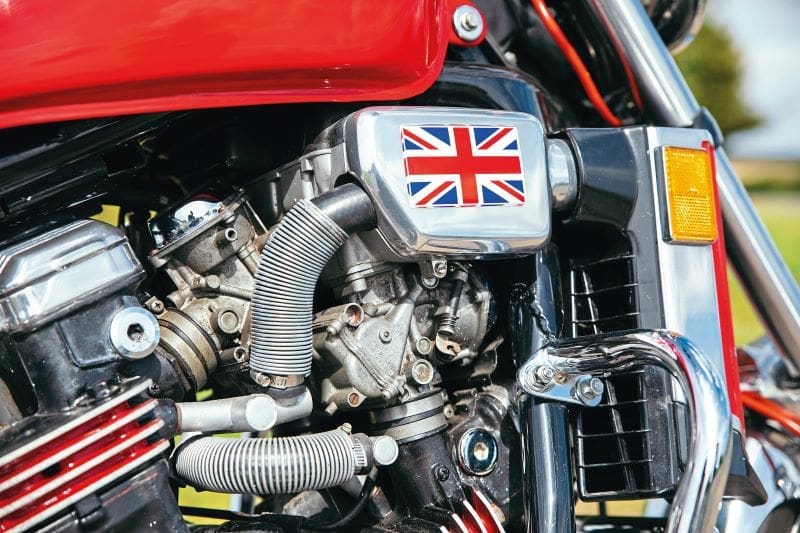

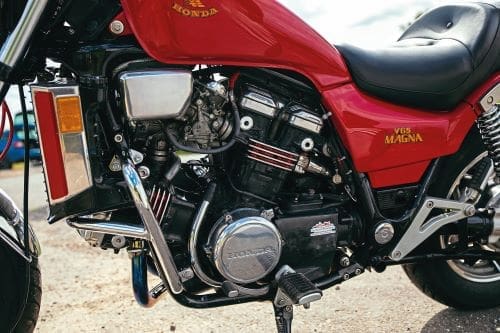
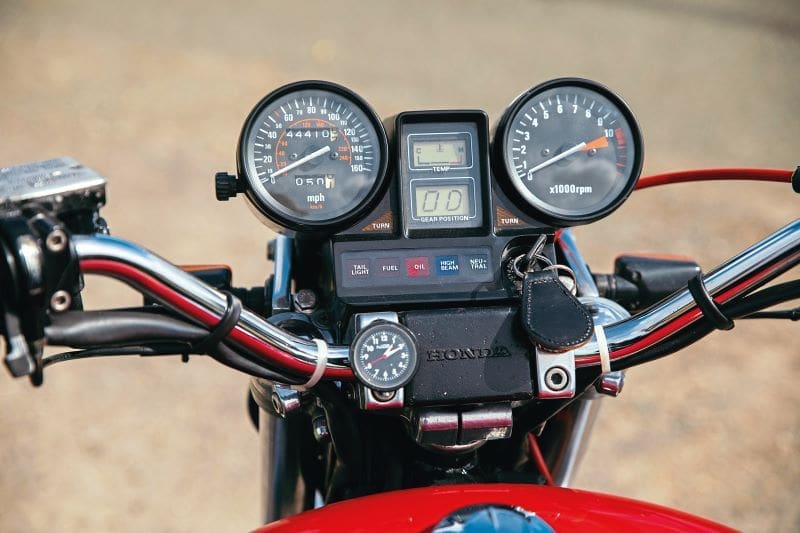
Everything about the bike is there to impress and it’s taking no prisoners whatsoever. Our test bike isn’t 100 per cent, reference book perfect (this is Red Molly we’re talking about) but it’s close enough for our critical evaluation…
First off are those long forks kicked out at an almost chopper-esque angle; they look like they’ll make the bike feel odd to ride, but more of that later. The next thing to grab your eye is the motor which is literally ‘mahusive’ from every possible angle. In order to get the thing in a bike frame and not compromise ride height or wheelbase too much, the V4 lump had to be housed with the rear bank of pots tilted up a little towards the vertical which then drops the front bank down. It’s probably the ideal siting but you’d have to say it’s not the prettiest motor ever built and probably, from an aesthetic perspective, much better off behind a fairing to be honest like the VF1000 sports bike.
The rear guard/seat/tank combo are designed to visually flow into one another which they do to a fair degree but then, to European eyes at least, the dynamic is damaged by the obligatory Americana sissy-bar-cum-backrest. Almost as an afterthought and in a nod to practicality (yes, hard to believe I know) there’s a small rear rack over the rear guard in case the rider wants to nail on a bed roll, tent, etc. Back at that apparently small fuel tank it’s officially referred to in the owner’s handbook as the reserve tank; the real thing is sited under the rider’s backside and there’s a lift pump in there as well…somewhere. In reality it’s all something of a strange sop to Honda’s period obsession with mass-centralisation and not anything you’d immediately associate with this kind of machine. And, at this point in time, Honda finally had begun to learn, just before the Magna was first launched, that there was an overt need to get regulator/rectifier units out in the fresh air. The similarly-styled VF750S had been badly affected by overheating electrical control units so at last the V65’s was sited just above the right-hand side’s swingarm’s pivot where it could properly let off steam instead of being buried away somewhere out of the air-flow.
There are no Comstar wheels here and Honda probably realised that only strong, conventional, cast alloys would be up to the job on the rear-end at least. Let’s be frank here: who would want to test the patience of a handful of alloy rivets pressed through aluminium spokes on to a similar rim with all that V4 grunt on offer? That 1100 motor was built for acceleration and probably has the ability to out-perform a Comstar’s capabilities – a perfect example of the firm’s attempts to reinvent the proverbial.
With shaft-drive transmission, the swingarm forms the outer cover for the final drive on the right side with a pair of suitably-robust Hagon replacement rear shocks supplanting the originals which doubtless the bike ate within the first 2000 miles of use. Our test bike runs a semi-generic 4-1 exhaust system necessitated by financial expediency. As an American-only machine there are no aftermarket systems readily available here and importing one from across the pond was always going to be prohibitively expensive.

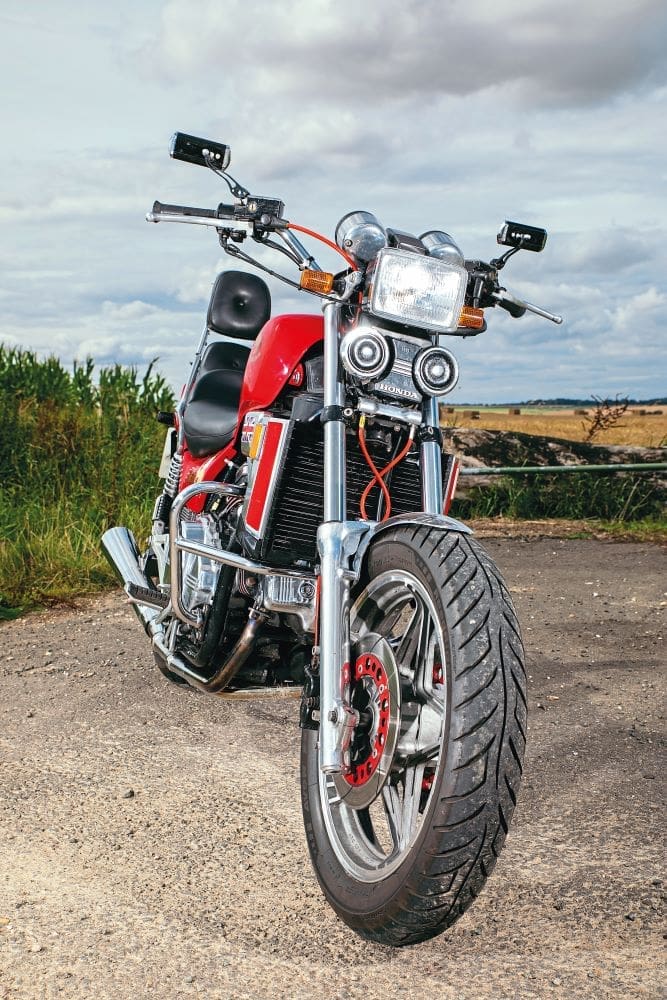
I could examine and analyse all day but the time has come to climb aboard and spur the beast into life. Being a Honda and despite all the ostentation it, of course, starts on the button each and every time and, on this example at least, makes a fair old racket. Those down-pipes are single skinned, not twin like the OEM set up so don’t exactly mute the exhaust’s note. As might be expected, the riding position is positively alien for riders of more conventional machinery, modern or classic. The bars hang you out like a sail and the foot-pegs are forward set, yet not as far as on some metric cruisers, thankfully. That K&Q (King & Queen) seat is, initially at least, comfortable and actually makes a lot of sense when you open the throttle.
Be under no illusion, despite its profile, intended purpose and every camp/macho/poseur cliché you can conjure up, this thing motors… and how! From just 2000rpm on that tacho the Honda delivers serious stomp and the stepped saddle immediately comes into its own. There’s an almost seamless drive and a huge lunge towards the next bend or the horizon depending on your vista. The back of the rider’s seat suddenly becomes your best friend as it prevents you hurtling rearwards. Change up when you like and allow that hugely-impressive V4 to tramp on; the empty backroads of Lincolnshire make little difference which ratio you’ve selected as there’s torque aplenty.
You’d not expect a machine designed for interstate mile crunching and boulevard cruising to be a viable handler and initially it all does all feel a little uneasy. On unknown roads of variable and unpredictable quality I find I’m being unduly cautious and the best way I can get the Magna to turn predictably without giving me palpitations is to almost ‘hang off’ the thing. Hanging off the side of a cruiser is frankly odd either to do or to see and so, as my confidence levels rise, I start to put more faith in the rubber and the chassis.

Amazingly, this bike is actually quite predictable once you let it do what it wants to rather than trying to enforce your own, preconceived, riding style upon it. Suddenly we’re getting on a whole lot better but there’s still no room for complacency; there’s a lot of power on tap here and I’m reminded that Honda implied a top-end of 150mph so respect is the name of the game.
Now that we’re in harmony (or close to it), confidence levels rise and it’s perfectly possible to hustle around the wider roads without issue. The ride is plush yet firm and, ultimately, predictable. My only serious gripe is that the riding position holds you firmly in one position with no room to move around on the seat. After an hour or so it’s readily apparent that you’re taking most of your weight on your tailbone which ultimately starts to ache. However, given the bike’s remit this really is the only obvious negative I can honestly flag up.
Those extravagant forks are genuinely much better than they look and don’t seem to adversely affect the ride but then again this is, after all, a Honda so it’s not going to have any real issue like that is it? Those multi-piston calipers are up to hauling all that mass down well enough at legal speeds but how they perform over three-figure speeds is anyone’s guess and no, I’m not up for it! Surprisingly, the anti-dive mechanisms seem to function rather well on this example at least. A decent fist of best front brake retards forward motion yet the expected and impending fork dive is actually minimal which I find rather impressive and swiftly easy to get used to.
Ultimately, the V65 is a big bike with a lot of grunt and trying to manoeuvre it around for riding shots or statics is a task in itself. Despite Honda’s supposed ‘mass centralisation’ you’re left in no doubt as to the Magna’s magnitude in your hands, leg muscles and back and yet, within the constraints of the design remit, it’s manageable. Yes, it is unequivocally a brute of thing but when your park it up and use the centre-stand this leviathan jumps up on it better than many middleweights I’ve sampled. If you buy into what the bike is supposed to be and don’t expect sports bike levels of handling it’s more than up to its intended task. However, should you try to take advantage of its inherent, Honda instilled, manners I’m sure it will, at some point, bite back and bite hard.
To a point the bike is form over function and, for its running gear, possibly insanely fast but, for once, we definitely have a Honda with character and there’s nothing dumbed down about it. Doubtless it would probably come over as insipid to a long-term Yamaha V-Max rider but for me it’s more than enough. I am only too well aware of my own fragile mortality, even aboard ‘Red Molly’!
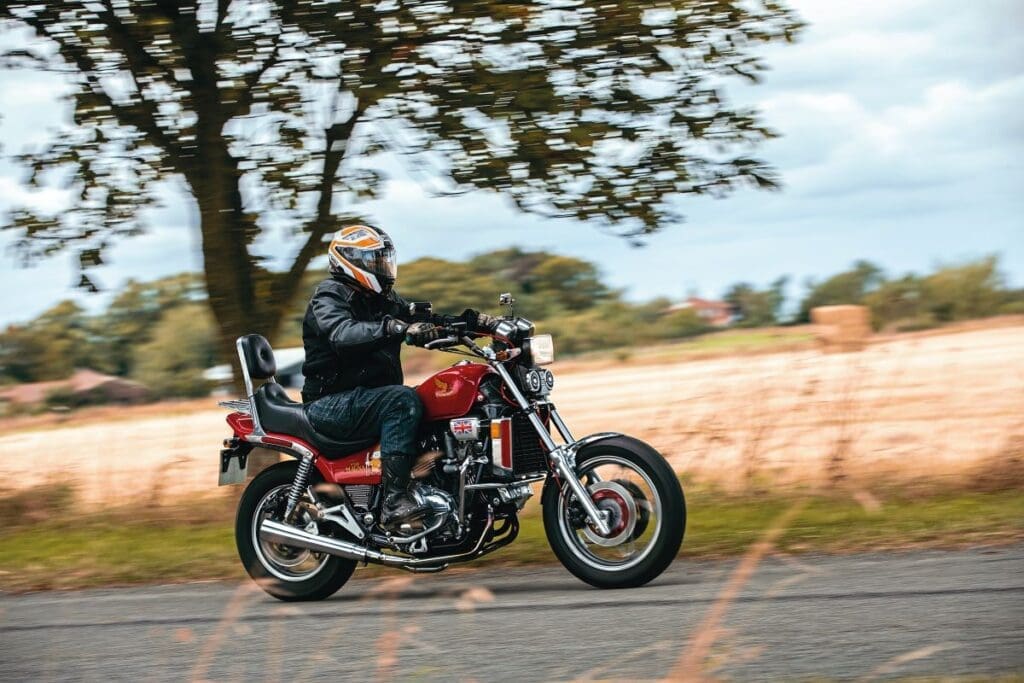
The owner’s view by Andy Jones
“I’ve always loved the absurd, especially the mechanically absurd. Doesn’t matter what it is, if it’s unusual or unworkable, I’ll take an interest. That’s kind of why I ended up owning a Honda V65 Magna; I wanted something different.
I mean big cruisers are lumpy V-twins, aren’t they? Certainly not normally fairly free-revving V4s with 16 valves and four cam-shafts all supplied with the volatile stuff via four large bucket-like carburettors. That, however, is exactly what the Magna is though; extreme some might say, but never dull or dumbed down. In fact, it’s as if when the guys from Honda sat round the table looking to design the thing, they had a collective brainstorm. Every odd device that the experimental department could stretch 1980s electrical relay-based technology to perform ended up on the Magna it seems – some of which are best forgotten if I’m being honest here. It also features the Honda TRAC anti-dive fork system and air-cushioned suspension. The TRAC system only works on one fork leg and relies on a hefty fork brace for the other leg to follow suit; the replacement brace on mine was made from a chunk of A380 Airbus wing spar by a friend!
This particular Magna was rebuilt by me from what were two essentially wrecked and exhausted bikes, bought from a guy on Gumtree. Both were American imports at some point, and one was still sporting a car park sticker from a college in California from the Fall Term of 1986.
So what’s it like to ride? Well, it’s docile enough if one want it to be. It can be slotted into ‘overdrive’ (sixth gear) at 45mph without too much trouble and she’ll trundle along at 60-ish all day if that’s what you want. However, should one crack the throttle open and get her above 5000 revs in, say, fourth gear, then a lot happens quite quickly. Handling-wise, she isn’t too shabby, obviously not like a sports bike but crisp enough for what it is. The TRAC anti-dive system seems to work okay; I wasn’t sure myself but your scribe for this piece reported favourably upon it. Brakes are more or less what you’d expect: two reasonable front discs and a bigger single one at the back haven’t caused any drama so far, so all in all a fairly competent, if somewhat complicated, package for 1983. Great fun and still catches people’s eye.”
Honda’s V4 ‘Magna Carta’

There is, perhaps, a supreme irony to the V65 in that its inception dates back to 1979 when The Big Aitch went back to GP racing with an oval-pistoned V4 which was essentially a V8 minus a few cylinder walls.
Even though that bike was a failure the concept of compact four-pot motors with integral cylinder blocks had been established within Honda R&D Department’s psyche. The first production bike to use the set up was the ill-fated VF750S, which was followed swiftly by the slightly improved if similarly jaundiced VF750F. The former bombed in sales due to its odd-ball styling as a metric cruiser like nothing else, overheating electrics and collapsing chassis. The sports version gained an evil reputation as an eater of cams and cylinder heads. After much burning of late-night oil the V4 concept was reborn with serious manifold revisions and updates.
One of the spin-offs of this early engine revision programme was the V65 Magna was aimed fair and square at the competition such as Kawasaki’s Eliminator, Yamaha’s V-Max and Suzuki’s Madura. Despite being over-powered for the suspension, handling and tyres of the period, the big muscle, four-pot cruisers proved to be extremely popular with American riders who liked the look of Harleys but not the rudimentary engineering within.



